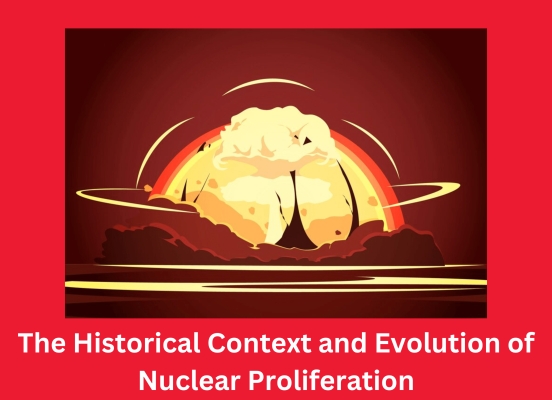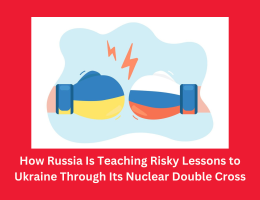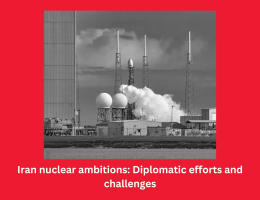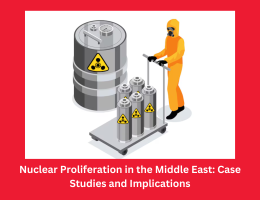
The Historical Context and Evolution of Nuclear Proliferation
- By admin --
- Saturday, 09 Mar, 2024
Introduction:
The development and proliferation of nuclear weapons stand as one of the most significant and contentious issues in modern history. Understanding the historical context and evolution of nuclear proliferation is crucial for comprehending its present-day challenges and implications. This essay delves into the key historical milestones, events, and trends that have shaped nuclear proliferation over the past century.
Early Developments and World War II:
The roots of nuclear proliferation can be traced back to the scientific advancements of the early 20th century. The discovery of nuclear fission by physicists such as Otto Hahn and Fritz Strassmann in 1938 paved the way for the harnessing of nuclear energy for destructive purposes. This scientific breakthrough captured the attention of governments worldwide, particularly during the tumultuous years leading up to World War II.
The Manhattan Project, initiated in 1942, epitomized the race to develop nuclear weapons. Led by the United States, the project brought together some of the world's brightest scientific minds, including physicists like J. Robert Oppenheimer and Enrico Fermi. The successful testing of the first atomic bomb, code-named "Trinity," in July 1945 marked a pivotal moment in history, demonstrating the devastating power of nuclear weapons.
The Atomic Age and the Cold War:
The use of atomic bombs on Hiroshima and Nagasaki in August 1945 ushered in the Atomic Age and fundamentally altered the global security landscape. The end of World War II saw the emergence of the United States and the Soviet Union as superpowers, locked in a bitter rivalry known as the Cold War. Nuclear weapons became central to the strategic calculations of both nations, leading to a frenzied arms race characterized by the pursuit of larger arsenals and more advanced delivery systems.
The advent of thermonuclear weapons, or hydrogen bombs, in the early 1950s escalated tensions further, raising the specter of mutual assured destruction (MAD). The doctrine of MAD posited that the possession of sufficient nuclear capabilities by both superpowers would deter aggression, as any nuclear conflict would result in catastrophic consequences for all parties involved.
The Spread of Nuclear Weapons:
Despite efforts to maintain a monopoly on nuclear weapons, the United States' successful test of the Soviet Union's first atomic bomb in 1949 shattered illusions of exclusive nuclear supremacy. This development, coupled with advancements in nuclear technology and the emergence of new nuclear-armed states, marked the beginning of nuclear proliferation.
The United Kingdom became the third nation to develop nuclear weapons, conducting its first successful test in 1952. France followed suit in 1960, asserting its status as a nuclear power with the detonation of its first atomic bomb. The proliferation of nuclear weapons accelerated in the ensuing decades, with China joining the nuclear club in 1964 and subsequent proliferation efforts by countries such as Israel, India, and Pakistan.
Proliferation Challenges and Non-Proliferation Efforts:
The spread of nuclear weapons posed significant challenges to international security, raising concerns about the risk of nuclear conflict, accidental launches, and nuclear terrorism. In response, the international community sought to mitigate the dangers of proliferation through diplomatic initiatives and multilateral agreements.
The Treaty on the Non-Proliferation of Nuclear Weapons (NPT), opened for signature in 1968, remains the cornerstone of global non-proliferation efforts. The NPT aims to prevent the spread of nuclear weapons, promote disarmament, and facilitate the peaceful use of nuclear energy. Signatories to the treaty pledge not to acquire nuclear weapons, while nuclear-weapon states commit to disarmament negotiations in good faith.
Despite the NPT's provisions, challenges to nuclear non-proliferation persist. The emergence of rogue states and non-state actors seeking nuclear capabilities, coupled with advancements in nuclear technology and the erosion of arms control agreements, present ongoing threats to global security.
Conclusion:
A combination of scientific innovation, geopolitical antagonisms, security imperatives and the historical background plus the way it has evolved are responsible for bringing with it nuclear proliferation. This began with the first atomic bomb created during WWII and still goes on now whereby terrorists can access these weapons enabling it to become a global concern while there is also regional spread.
The persistent legacy of nuclear weapons requires collective efforts that would enforce non-proliferation regimes and encourage disarmament programs while dealing with the root causes of insecurity resulting from nuclear weapons. It is only through continued partnership and team work that risks posed by these weapons could be adequately managed and eventually obliterated.





